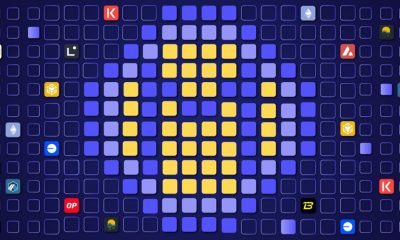Opinion
5 Best Web 3.0 Coins to Buy in January 2022
Securities.io maintains rigorous editorial standards and may receive compensation from reviewed links. We are not a registered investment adviser and this is not investment advice. Please view our affiliate disclosure.

The internet has been around for decades now, and ever since it was first invented, it has been in a constant state of development. Like a living organism, it grew and improved itself, becoming better, faster, richer with content, and eventually, massively adopted. However, even so, we are still separating it into two eras that we have seen so far.
The first stage of the internet is called Web 1.0, and it included only a handful of content creators, with the majority of the users being content consumers. It mainly consisted of personal web pages, which in turn consisted of static pages. As a result, the content was served from the servers’ file systems. However, over time, it evolved into Web 2.0, which is the internet that we know and love today, with all of its podcasting, blogging, tagging, social networking, and more.
However, just like Web 1.0 ended up being replaced with a superior Web 2.0, so will Web 2.0 be replaced by Web 3.0. And, for Web 3.0 to arrive, we need blockchain technology and cryptocurrency, which will make the internet more decentralized, and once again, presumably better. This means that investing in projects that are bringing Web 3.0 means investing into the future, and if you wish to make this long-term investment, these are some of the best options out there.
1. Polkadot
Polkadot is an open-source shared multichain protocol that aims to do two things — resolve the issue of scalability in the crypto industry, and achieve interoperability among blockchains. The future of Web 3.0 depends on the blockchains’ ability to connect to one another, and since each chain exists in its own little bubble in which they are developing its ecosystems, there is a need to develop bridges that would allow for data and money to flow between them without interruptions.
Polkadot has developed a new approach that allows it to create and use parachains — parallel chains that run alongside its main blockchain. These parachains are meant to solve the issue of scalability by taking over a portion of the network’s transactions, thus reducing the load on the main blockchain. At the same time, they can be used for establishing a connection to other blockchains.
The project can connect to private or public chains, permissionless networks, oracles, other emerging technologies, and more. It is almost universal in that regard, and as such, one of the Web 3.0 projects with the most potential.
To learn more about this token visit our Investing in Polkadot guide.
2. Filecoin
The next project that we were interested in is Filecoin, which s a project that offers a decentralized storage system. The project has developed a great interest in how information is stored and managed, and we could say that it is dealing with it in a rather futuristic way.
You see, Filecoin thinks that the future of information is extremely important and that it needs to be stored somewhere safe. With no satisfying solution in the world, the project decided to create one, itself. Originally, when it was first created back in 2014, Filecoin was meant to be an incentive layer for the interplanetary file system. Essentially, it was P2P storage, which allowed storing data in a decentralized way.
In a sense, this would be similar to how cloud storage works, only cloud storage is not considered a good solution due to how centralized it is. Blockchain, on the other hand, addresses the centralization issue, and it can store any amount of data, and make it 100% immutable and transparent.
To learn more about this token visit our Investing in Filecoin guide.
3. Kusama
In the third spot, we have Kusama — a project that acts as an experimental platform based on blockchain technology. Kusama was created to provide a highly-scalable, interoperable framework for developers to test their projects and protocols.
Since it uses a nearly identical codebase as Polkadot, it is often seen as its “wild cousin,” where anything can happen. As such, it is also an ecosystem where you are most likely to find new and emerging opportunities. Of course, many of the projects that are launched here will end up being dead ends, but those that do work will go big quickly once the word spreads. As a result, keeping an eye on what Kusama has to offer can bring quite a few opportunities.
Despite its similarities to Polkadot, Kusama’s willingness to experiment has brought it many features that Polkadot’s network simply doesn’t have. Not only Polkadot, but no other network can offer what Kusama has. While it does act as a canary network, it is also a cradle of innovation, and that alone makes it worth investing following.
To learn more about this token visit our Investing in Kusama guide.
4. Ocean Protocol
Then, there is Ocean Protocol. This is another ecosystem developed on the blockchain, and it was developed to support businesses and individuals alike. Ocean’s goal is to allow its users to take control of their own data and monetize it, while it also allows you to keep it safe.
Basically, data is everything on the internet, and the old saying of “knowledge is power” has never been more fitting than today, in the digital world. The problem is that Web 2.0 allows anyone to just take your data and use it for their own purposes, in whatever way they see fit.
Ocean wishes to change that in Web 3.0, and make you the sole owner of your information. You can then choose to give it to someone, and decide whether they should see it, what they should be able to access, and alike. And, of course, it would not be for free. Instead, you would be able to sell it and actually profit from all those advertising companies that seek your information in order to target you with ads.
Ocean introduced datasets, which are packets of data that used to be difficult to access, or even impossible to see. Now they can be found within the Ocean Market, where they are bought and sold at will. It also has data tokens, which represent specific data services, and are used to wrap datasets. It is an interesting project meant to empower the user, so be sure to give it a look over.
To learn more about this token visit our Investing in Ocean Protocol guide.
5. Helium
Finally, we have Helium — a blockchain network that focuses on the IoT sector. The so-called Internet of Things consists of all kinds of devices and gadgets that have allowed us to create smart homes, and that will even be used in the development of smart cities someday. All of these devices have a connection to the internet, and they can feed it data that they are collecting from the real world, or display data that they are collecting from the web.
Helium’s goal is to connect them to one another in a new and improved way, allowing them to communicate with one another, share their data seamlessly, and make the IoT as productive and as convenient as it can be.
Its network consists of nodes operated by users, and operating a node also means being able to mine Helium’s HNT tokens and receiving rewards. So, keeping the network going is profitable for the nodes, and at the same time, it can be highly useful for the society, which is why this project could be the go-to project for any city of the future that might decide to modernize and take a step closer to becoming autonomous.
To learn more about this token visit our Investing in Helium guide.
Conclusion
The internet is changing and evolving, seeking to become better, and the projects mentioned above are all working on making it happen by developing solutions that will ultimately connect different chains, and make up the architecture of Web 3.0. As such, these may very well be some of the most important projects for the future of the web itself, which is almost a guarantee that they have a future, and that it is going to be a very bright and important one.












